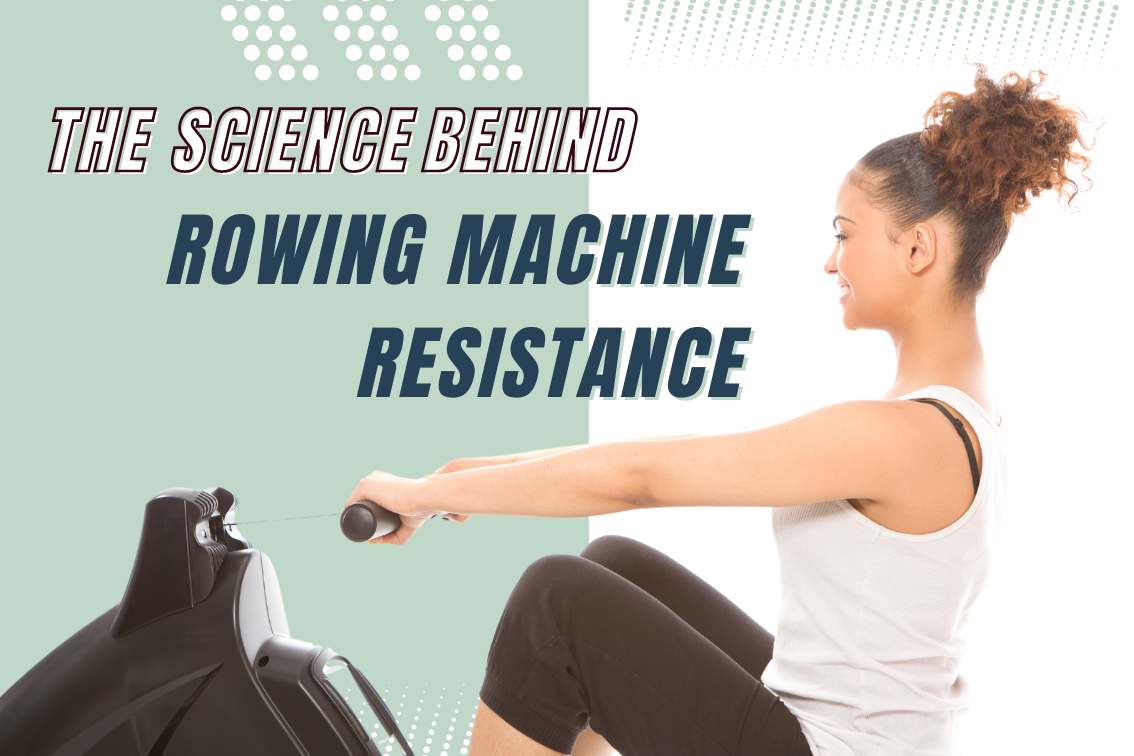The Science Behind Rowing Machine Resistance

Table of Contents
In this article
What’s not to love about a rowing machine? They offer a comprehensive, low-impact workout that engages multiple muscle groups while providing an intense cardiovascular challenge. As rowing gains popularity—both in gyms and home setups—understanding the various mechanisms behind these machines becomes crucial.
Resistance is the backbone of any rowing machine, dictating the intensity and quality of your workout. However, not all resistance types are created equal. From air and water to magnetic and hydraulic, each type brings its own set of features, benefits, and drawbacks. How resistance is generated can profoundly impact your overall fitness experience, from muscle engagement and cardiovascular strain to noise levels and maintenance requirements.
We’re going to delve into the science behind rowing machine resistance. We’ll explore the mechanics of each resistance type, uncover the physics at play, and help you understand how to choose the best machine to align with your fitness goals and lifestyle. Whether you’re a seasoned rower looking to replicate the feel of water or a newbie seeking a quiet, efficient workout, we’ve got you covered.
Primer: Understanding Rowing Machine Resistance
Definition of Resistance in Rowing Machines
Resistance in rowing machines refers to the force that opposes the rowing motion, simulating the effort required to propel a boat through water. It’s the key factor that determines how challenging your workout will be. The greater the resistance, the more effort you must exert to complete each stroke, leading to increased muscle engagement and cardiovascular exertion.
Importance of Resistance Mechanisms
Different resistance mechanisms simulate various rowing conditions and cater to distinct workout preferences. The type of resistance impacts:
- Cardiovascular Training: Heart rate response and overall cardio workout quality.
- Muscle Engagement: Specific muscle groups activated and the intensity of their engagement.
- Workout Smoothness: How fluid and natural the rowing motion feels.
- Progression: How easily you scale up the difficulty to match fitness improvements.
Types of Resistance Mechanisms
The primary types of resistance mechanisms in rowing machines include:
- Air Resistance: Uses a flywheel and fan to generate resistance.
- Water Resistance: Works by moving paddles through a water tank.
- Magnetic Resistance: Uses magnetism to create drag on a flywheel.
- Hydraulic Resistance: Involves hydraulic pistons filled with fluid.
Each type has unique characteristics that suit different workout environments and fitness objectives.
Purpose of This Article
I’m going to walk you through each type of resistance. For each resistance type, I will:
- Explain the Science: Dive deep into how each resistance type works, not just the superficial characteristics.
- Compare Effectiveness: Provide a comparative analysis of energy expenditure, muscle engagement, and overall workout efficiency.
By teaching you the science behind rowing machine resistance, I will empower you to make an informed decision so you can optimize your rowing workouts for maximum benefit.
Types of Rowing Machine Resistance
1. Air Resistance
- Mechanism:
- Air resistance rowing machines use a flywheel with fan blades that spin as you pull the handle. The flywheel generates resistance by moving air through the blades.
- The resistance is directly linked to the speed of the rowing stroke: the faster you row, the more resistance you encounter.
- Dampers on some models allow for manual adjustment of how much air enters the flywheel housing, affecting how heavy or light the stroke feels.
- Resistance Characteristics:
- Dynamic and scalable resistance: Increases with stroke intensity.
- Offers a smooth and natural rowing stroke, closely mimicking the feel of rowing on water.
- Pros and Cons:
- Pros: Smooth stroke dynamics, adjustable resistance, durable design suitable for high-intensity workouts.
- Cons: Noisy due to air movement, generally larger, and requires periodic maintenance (e.g., cleaning the flywheel of dust).
2. Water Resistance
- Mechanism:
- Water resistance rowing machines utilize a water-filled tank with paddles attached to the flywheel. Pulling the handle moves the paddles through the water, creating resistance.
- The resistance dynamically adjusts according to the speed and power of your stroke. More water in the tank can also increase resistance.
- Resistance Characteristics:
- Provides a realistic rowing experience with the feel and sound of rowing on water.
- The resistance is variable and directly proportional to your rowing effort.
- Pros and Cons:
- Pros: Authentic rowing feel, therapeutic water sounds, aesthetically pleasing designs often made of high-quality materials like wood.
- Cons: Typically more expensive, requires regular maintenance to keep the water clean and free of algae buildup.
3. Magnetic Resistance
- Mechanism:
- Magnetic resistance rowing machines use magnets that create drag on a metal flywheel. The position of the magnets relative to the flywheel determines the resistance.
- Resistance levels are adjusted manually with a dial or through electronic controls, enabling consistent resistance regardless of stroke speed.
- Resistance Characteristics:
- Provides smooth, consistent resistance that can be adjusted to the user’s preference.
- Unlike air or water rowers, the resistance remains constant and doesn’t fluctuate with rowing speed.
- Pros and Cons:
- Pros: Quiet operation, smooth rowing experience, often compact and easy to store, adjustable resistance.
- Cons: Lacks the dynamic feedback of air and water rowers, some models may not be as durable.
4. Hydraulic Resistance
- Mechanism:
- Hydraulic rowing machines use pistons filled with incompressible fluid, usually oil, to create resistance.
- Moving the handles compresses the fluid in the pistons, generating resistance. The resistance can be manually adjusted by controlling the piston mechanisms.
- Resistance Characteristics:
- The rowing motion may feel less smooth and realistic compared to air or water rowers.
- Resistance can be uneven due to the condition of the hydraulic pistons.
- Pros and Cons:
- Pros: Most affordable, compact size, easy to store (many models are foldable), suitable for beginners.
- Cons: Less smooth rowing experience, uneven resistance, lower durability, doesn’t replicate the feel of rowing on water.
5. Hybrid (Air and Magnetic) Resistance
- Mechanism:
- Hybrid rowing machines combine air and magnetic resistance systems to offer versatile and comprehensive workout options.
- The air resistance provides dynamic feedback proportional to rowing speed, while the magnetic system allows for consistent, adjustable resistance.
- Resistance Characteristics:
- Offers the dynamic resistance of air rowing with the consistent, adjustable resistance of magnetic rowing.
- Allows for versatile training, suitable for both intense cardio sessions and strength-focused workouts.
- Pros and Cons:
- Pros: Versatile resistance options, combines benefits of both air and magnetic rowers, suitable for various training goals.
- Cons: Can be more expensive, potentially more complex to operate, requires a power source for magnetic adjustments.
Physics of Resistance in Rowing Machines
- Air Resistance:
- Scientific Explanation: The drag force increases with the square of stroke speed (F_d = 1/2 * ρ * v^2 * A * C_d).
- Faster strokes create higher wind speeds in the flywheel, increasing resistance.
- Water Resistance:
- Fluid Dynamics: The resistance comes from the paddles displacing water, adhering to Bernoulli’s principle and fluid friction laws.
- Paddle speed and water viscosity play key roles in resistance.
- Magnetic Resistance:
- Eddy Currents: Magnets induce currents in the flywheel, creating opposing magnetic fields (Lenz’s Law).
- Closer magnet positions increase resistance by enhancing magnetic drag.
- Hydraulic Resistance:
- Fluid Mechanics: Resistance is produced by moving a piston through a fluid, relying on the principles of compressibility and viscosity.
- The force required increases with piston speed and fluid density.
Comparative Analysis of Resistance Types
Efficiency and Effectiveness
- Energy Expenditure:
- Air Resistance: Dynamic resistance increases energy expenditure with intensity. Ideal for high-energy cardio workouts.
- Water Resistance: Provides a balanced cardio and strength workout, with energy expenditure scaling with effort.
- Magnetic Resistance: Consistent resistance helps maintain steady energy output; ideal for controlled cardio and strength training.
- Hydraulic Resistance: Variable energy expenditure; may not be as high due to uneven resistance and less fluid motion.
- Workout Efficiency:
- Air and Water: Both excel in delivering efficient, full-body workouts.
- Magnetic: Highly efficient for controlled, steady-state workouts.
- Hydraulic: Less efficient due to potential inconsistency in resistance.
Impact on Muscle Engagement
- Air and Water Resistance:
- Engage a wide range of muscle groups: legs (quadriceps, hamstrings), back (latissimus dorsi, trapezius), core (abdominals, obliques), and arms (biceps, triceps).
- Dynamic resistance ensures comprehensive muscle engagement throughout the workout.
- Magnetic Resistance:
- Smooth, consistent resistance allows for targeted muscle engagement.
- Beneficial for controlled strength training and progressive overload.
- Hydraulic Resistance:
- Muscle engagement can be more localized and less effective due to resistance variability.
- Focuses more on arm and leg muscles due to the pulling motion.
Conclusion
Choosing the right rowing machine resistance requires carefully considering your needs, fitness objectives, and practical circumstances. Whether it’s the dynamic resistance of air rowers, the authentic feel of water rowers, the quiet efficiency of magnetic rowers, or the budget-friendly compactness of hydraulic rowers, understanding the science behind these mechanisms is key to making an informed decision. Equip yourself with the knowledge to enhance your rowing experience and achieve your fitness goals effectively.
